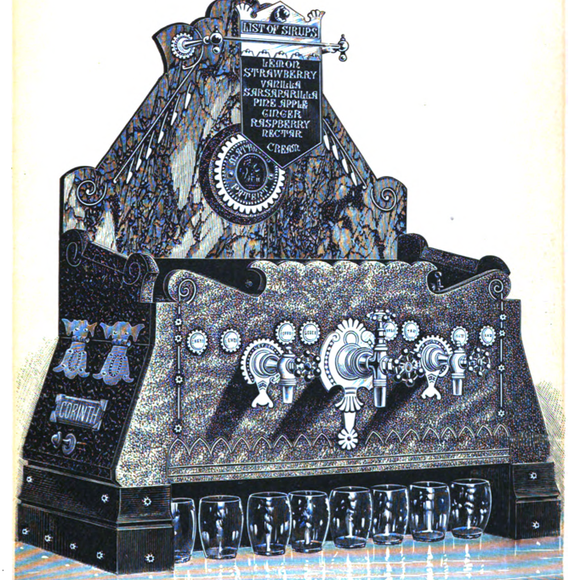Soda these days is, at best, a three-sense experience: It tastes sweet, it feels cool, and, if you listen closely, you can hear it fizz. Back in Victorian times, though, the refreshing beverage came with a dose of visual pizzazz. If you wanted a glass of flavored, carbonated water, you had to get it from a soda fountain—most of which were massive, opulent affairs, incorporating Greek statuary, marble accents, rows upon rows of bright metal spigots, and the occasional taxidermied animal head.
The bare-bones soda fountain was invented by John Matthews, a British expat who came to New York in 1832. Hoping to make his fortune in fizzy mineral water—a popular drink that was said to heal various ailments—Matthews invented an easy-install carbonation machine and peddled it to drug stores around New York City. Once proprietors added syrups, fruit juices, oils, and creams to their drinks, the soda craze began in earnest.
Matthews introduced the soda fountain—but G.D. Dows, a chemist from Lowell, Massachusetts, made them beautiful. In the late 1850s, Dows built a machine with an automatic ice shaver, a soda-water tube, measuring decanters, and six syrup spigots, each with a tiny silver eagle perched on top. He then covered the fountain in local marble. It was a smash hit, and Dows quit his job as a drugstore clerk to became a soda fountain designer.
Over the next several decades, Dows, Matthews, and others raced to outdo each other. They designed machines with spinning carousels, tiled mosaics, embedded jewels, and musical automatons. The 1876 Centennial Exposition boasted over a dozen fountains, including a three-story one, called the Mammoth, that had 76 spigots. One story of the era involved an old woman mistaking a soda fountain for a war memorial.
This soda fountain arms race continued up through the early 20th century, when technological innovations meant proprietors could buy their gas in canisters, removing the need for huge machines. This led, eventually, to the more familiar 1950s soda shop aesthetic: less baroque, more sleek, with the remaining mechanical bits hid underneath the counter. Like many large creatures, the monstrous soda machines had been driven to extinction.
So next time you crack open a cold, fizzy can, or mix some graveyard soda from a fast food restaurant’s multi-tabbed machine, pour out a slug for the lost fountains of yore.
Where to Try It
-
New Orleans Pharmacy Museum
514 Chartres Street, New Orleans, Louisiana, 70130, United StatesThe museum's soda machine is not the most gargantuan example of an early soda fountain, but it has a cool, steampunk vibe.
Written By
 Cara Giaimo
Cara Giaimo
Sources
- www.atlasobscura.com/articles/victorians-drank-soda-out-of-monstrous-gilded-machines
- books.google.com/books?id=-C_OAAAAMAAJ&dq=gustavus+d.+dows&source=gbs_navlinks_s
- books.google.com/books?id=Wr_yPYvkNWwC&vq=matthews&source=gbs_navlinks_s
- books.google.com/books?id=X8JBAQAAMAAJ&source=gbs_navlinks_s
- www.americanheritage.com/content/soda-fountain














